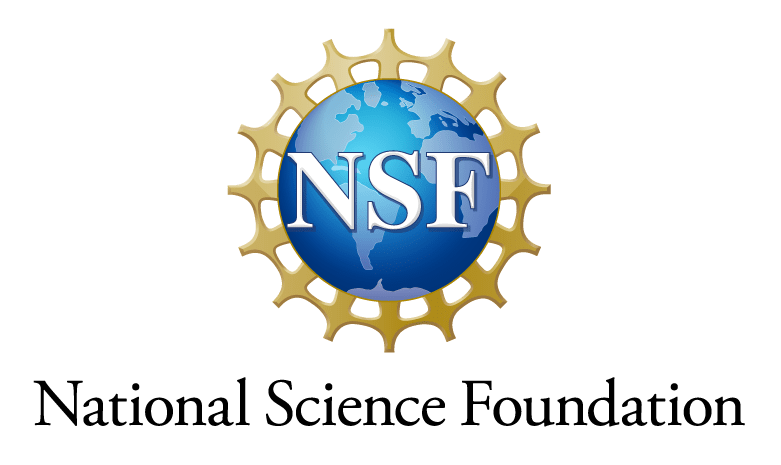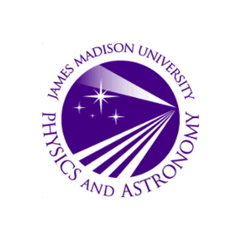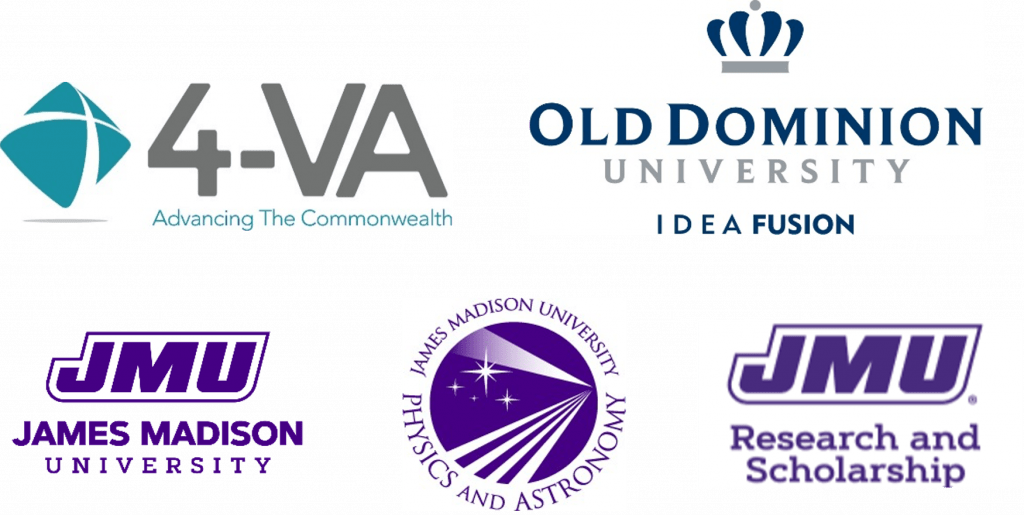Grants

Current research projects at MAL are funded by the National Science Foundation, as follows:
Award No. 1913258: $218,758 – Adriana Banu (PI/JMU)
RUI: Exploring the origin of the rarest stable isotopes via photon-induced activation studies at the Madison Accelerator Laboratory (2019 – 2022, extended until 2023)
Abstract
The question of how nuclear reactions in stars and stellar explosions have forged the elements out of hydrogen and helium leftover from the Big Bang is a longstanding but timely research topic in nuclear astrophysics. There is a fairly complete understanding of the production of the elements up to iron by nuclear fusion reactions in stars but important details concerning the production of the elements beyond iron remain puzzling. The proposed research aims to advance fundamental knowledge on a forefront topic in nuclear astrophysics – the synthesis of elements beyond Fe and of the rarest stable isotopes naturally occurring on Earth. The astrophysical phenomenon responsible for this synthesis is termed the p-process. Though simulating the p-process nucleosynthesis on a computer is a daunting task, significant progress can be made by performing key measurements which constrain the models that are used to calculate the unknown stellar reaction rates. Moreover, the proposed research will create a rich research experience for undergraduates in an accelerator-based environment at the newly opened Madison Accelerator Laboratory (MAL). MAL is a unique bremsstrahlung facility on the campus of James Madison University. The students will have an excellent opportunity for hands-on participation in an accelerator-based environment and they will be able to participate in cutting-edge research in nuclear astrophysics. This experience is an important part of their training as future researchers and will provide them with skills necessary to pursue STEM careers in industry or at national laboratories and universities.
The focus of this proposal’s research program is to determine experimentally the ground state reaction rates for eight photo-neutron reactions which are to be investigated by photon-induced activation at MAL. The eight photo-neutron reactions are: 64Zn(γ,n)63Zn, 70Ge(γ,n)69Ge,74Se(γ,n)73Se, 78,80Kr(γ,n)77,79Kr, 84,86Sr(γ,n)83,85Sr and 90Zr(γ,n)89Zr. The eight proton-rich stable nuclei of interest belong to the region A < 124 which is notoriously under-produced by the current stellar evolution models.
In the laboratory one only has access to target nuclei in the ground state and so the stellar photodisintegration reaction rates, dominated by excited state contributions at the high temperature regime of the p-process, cannot be directly constrained experimentally. With the experiments at MAL, we can instead provide nuclear science input (through inverse reaction kinematics) to constrain crucial parameters of the nuclear reaction models, i.e., γ-ray strength function especially relevant for photo-neutron reactions. Considering the very large number of nuclear reactions involved in the production of even a single p-nucleus, any new measurement of photodisintegration reactions relevant to the p-process path will put the nucleosynthesis calculations on a firmer foundation.
This award reflects NSF’s statutory mission and has been deemed worthy of support through evaluation using the Foundation’s intellectual merit and broader impacts review criteria.
Award No. 2138367: $300,000 – Jessika Rojas (PI/VCU) & $18,411 – Adriana Banu (PI/JMU)
Collaborative Research: Studies of light-responsive novel metal and lanthanide-based nanocomposites: X-ray radiation enhancing and radioluminescence properties (2022 – 2025)
Abstract
Materials at the nanoscale have evidenced a wide and remarkable set of properties that make them suitable for many applications. The behavior of nanomaterials under various external stimuli, such as temperature, mechanical forces, pH, etc., has been widely investigated. However, the interaction of nanomaterials with ionizing radiation, such as X-rays, remains largely unexplored. Investigating potential phenomena and understanding the interaction mechanisms of ionizing radiation with matter at the nanoscale is an unknown question in materials chemistry and will generate valuable information to allow the use of such structures in nuclear science and technology for applications in medicine, power transducers, energy storage, radiation sensors, and actuators. This collaborative research proposal will investigate a novel class of multicomponent nanomaterials responsive to both low and high energy X-rays. This research will have a tremendous educational impact on the Mechanical and Nuclear Engineering program at Virginia Commonwealth University (VCU). The new knowledge in materials and radiation chemistry, advanced nanomaterials synthesis, and manufacturing will be disseminated in the undergraduate and graduate courses. The research proposed here will also be a significant boon for the nuclear science at James Madison University (JMU) and will include undergraduates in the interdisciplinary-research projects. The diverse experience the students will gain while working on this interdisciplinary project will create a multitude of opportunities for those seeking careers in nuclear engineering, applied photon science, nanoscience, accelerator physics, or medical physics, as well as for those directly entering the workforce in the nuclear industry or government.
This research project will advance both the fundamental understanding of the underlying mechanism of radiation dose enhancement and the radioluminescence response upon the nanocomposites interacting with high-energy photons. The work will build upon the theory of radiation interaction with matter and expand on the surface and interfacial effects in aqueous media that lead to the radiation enhancement phenomenon. This project focuses on three key areas: 1) Expand on the controlled synthesis of multicomponent nanomaterials to explore their mechanisms of interaction with ionizing radiation; 2) Investigate their radioluminescence and radiation enhancing properties; 3) Implement computational models based on Monte Carlo simulations to assess the contribution of the physical enhancement to the radiosensitization properties of the nanomaterials based on their chemical compositions and morphologies. The experimental work will involve chemical, electrochemical, and spectroscopic techniques to quantify reactive species involved in the radiation enhancement and the materials’ optical properties. Computational work will be carried out using GEANT4 particle transport code to model the interaction of the X-rays with the studied nanostructures. Ultimately, this research will establish correlations between the material structure and properties in the solid-state, specifically considering the effects of the X-ray parameters such as the energy spectrum of the X-ray beam and the rate at which the energy is delivered to the system have on the behavior of the materials systems. Overall, the proposed experimental and computational tools will lead to an understanding of the structure-property relationships of the nanomaterials and will advance the synthesis, evaluation, and simulation of radiation enhancing and radioluminescent nanomaterials to enable their implementation in various fields. Overall, both the undergraduate and graduate students involved in this work will have the opportunity to get hands-on experience in an accelerator-based environment at the JMU’s Madison Accelerator Laboratory while participating in cutting-edge interdisciplinary research both at VCU and JMU.
This award reflects NSF’s statutory mission and has been deemed worthy of support through evaluation using the Foundation’s intellectual merit and broader impacts review criteria.


STEM Center mini-grant to support development of middle and high school STEM experiences on campus: $2,500 - Harold Butner (PI/JMU)
Engaging students in the use of multiple wavelengths to probe the interior of an object at the Madison Accelerator Laboratory (August – December, 2022)
Abstract
Using the Madison Accelerator Laboratory (MAL), we will take several objects that are “hidden” and discuss what we can learn about them from observations at both visual wavelengths and other wavelengths, specifically X-rays. Middle and high school students would be presented with several small “boxes” and asked what they could learn about the objects – given rulers, scales (for masses). They then would be shown how X-rays could provide a different “interior view” of the same box.

4-VA Award: $12,500 – Adriana Banu (PI/JMU), K. Giovanetti (Co-PI/JMU), G. Niculescu (Co-PI/JMU), I. Niculescu (Co-PI/JMU), S. Pendleton (Co-PI/JMU), and G. Dodge (Co-PI/ODU)
“Workshop on the Science, Instrumentation and Education Program at the Madison Accelerator Laboratory” (June 22-23, 2017)
Abstract
This grant project is proposed in support of a 2-day collaborative research meeting entitled “Workshop on the Science, Instrumentation and Education Program at the Madison Accelerator Laboratory” to be held on June 22- 23, 2017 at JMU.
The Department of Physics and Astronomy at JMU has acquired a Siemens medical electron linear accelerator from the former Rockingham Cancer X-Ray Therapy Center, recently named the Madison Accelerator Laboratory (MAL). The facility can provide both electron and photon beams and it will serve as a unique bremsstrahlung research and educational facility in Virginia and in the region as it will become operational by Fall 2017. The scope of the workshop proposed here is to bring together experts from institutions worldwide with similar facilities as well as Virginia institutions with a shared interest in exploring opportunities at MAL. These opportunities include basic and applied research in nuclear physics, nuclear astrophysics, nuclear engineering, and homeland security. Much broader applications, such as accelerator physics, medical physics, materials science, environmental geochemistry, biology, or archaeology, will be discussed with the aim of promoting networking and collaborations within the state-wide community and beyond. MAL will also provide a unique platform for teaching undergraduate students in an accelerator-based environment, and it might support Virginia’s graduate research programs with students pursuing careers in nuclear/particle physics, nuclear engineering, or medical physics as well as for those directly entering the workforce in the nuclear industry or government. Hence, the workshop will explore possibilities of forging collaborations between the physics, nuclear engineering, and health sciences departments at JMU, across the state of Virginia and beyond for student training, course sharing and development of a diverse educational curriculum in applied photon science and accelerator physics. The PI also plans to integrate the outcome of this project into an NSF research proposal to be submitted in the near future.
